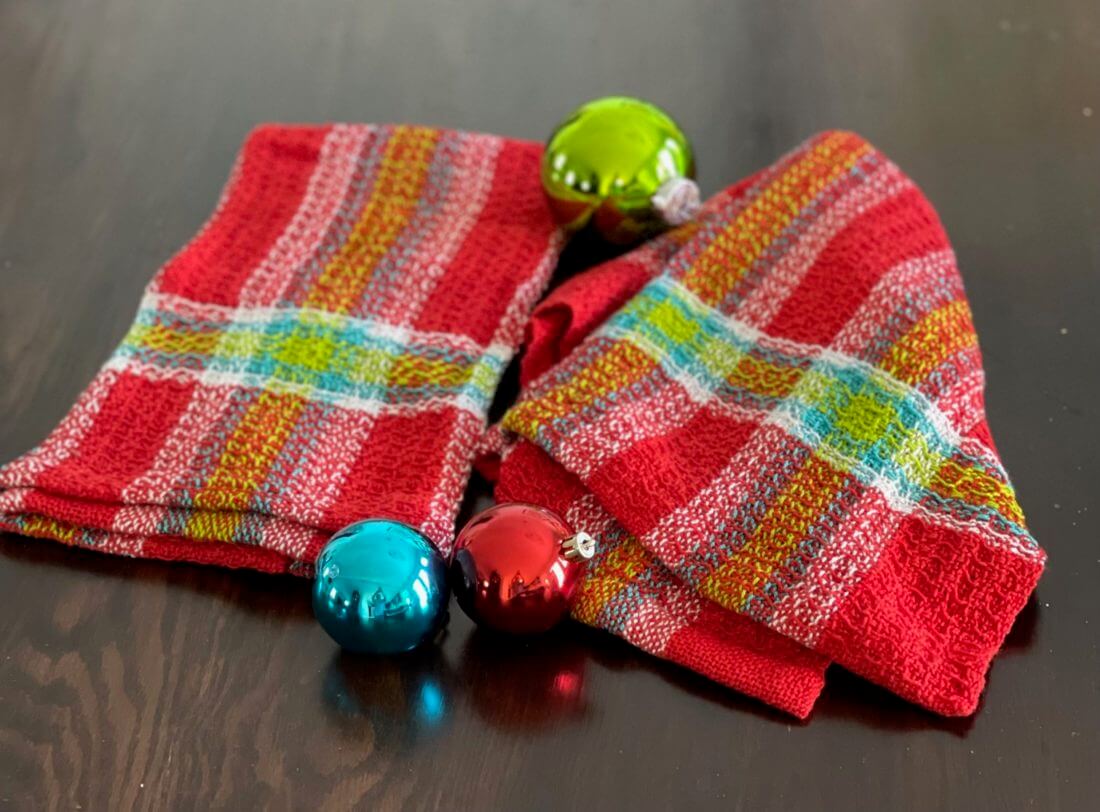These beautiful towels will add a festive touch to any kitchen, whether it be yours or the lucky recipient of a thoughtful, hand made Christmas or Holiday gift.
The weave structure is a version of waffle weave and requires the use of one pick up stick. It is slightly different than some waffle weave patterns that you may have seen since it has been modified for the rigid heddle loom. If it sounds complicated, don’t worry, it’s really quite simple and I’ve included lots of photos to help you out along the way.
Finished size: 28 1/2” x 19”
Pattern makes a set of two towels.
These towels were woven on a Kromski 32” Harp Forte rigid heddle loom. They would also fit on the 24”, but if you’re shopping for a new loom, consider the versatility of the extra width on the 32”. This pattern would also make a lovely baby blanket.
You will need a 10 dent heddle, a pick up stick and 2 stick shuttles. Extra shuttles will be helpful, but not necessary (I’ll share you a tip later on about that).
Also needed: 5/2 cotton weaving yarn.
I’ve used mercerized cotton.
Red = 588 yards
White = 327 yards
Turquoise = 198 yards
Bright Green = 132 yards
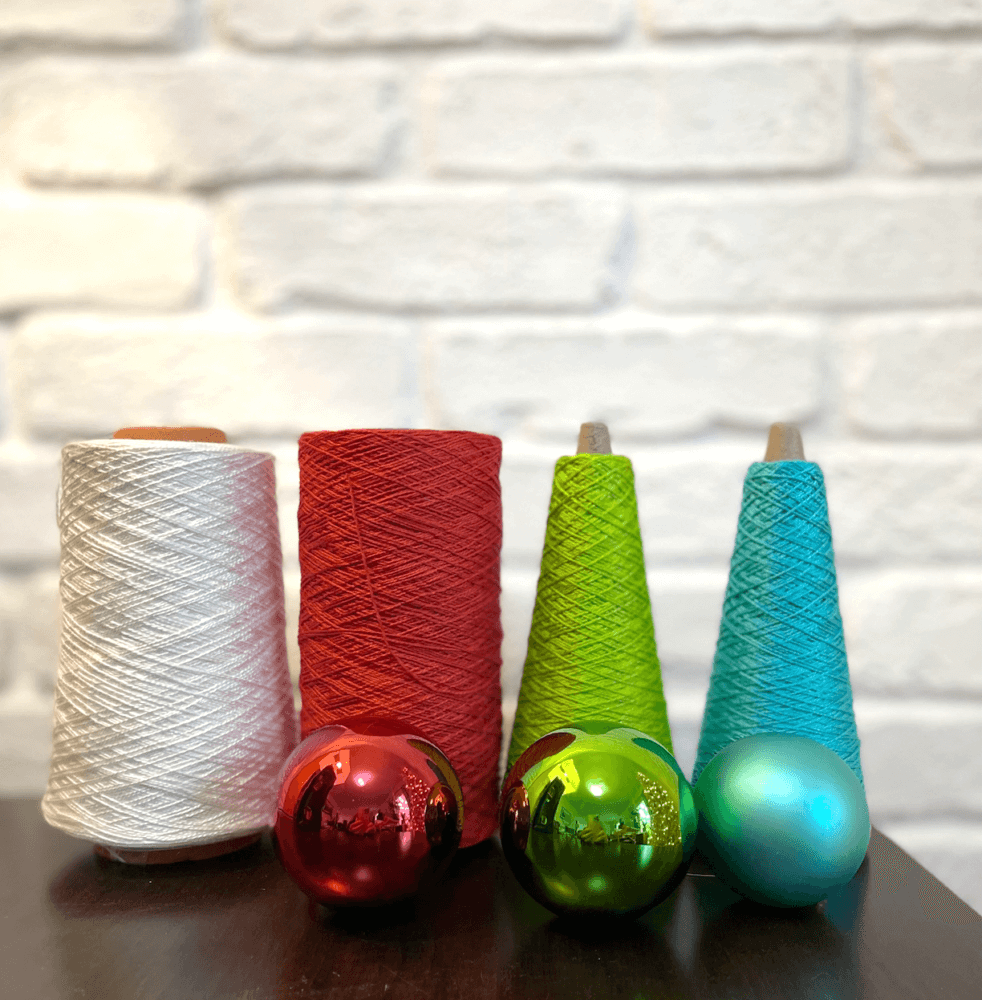
Warp the loom to a length of 98” as follows, with your preferred warping method.
The number of ends is included as well as the number of loops needed when using the direct warping method.
Red – 34 ends (17 loops)
White – 10 ends (5 loops)
Turquoise – 6 (3)
Green – 12 (6)
Turquoise – 6 (3)
White – 10 (5)
Red – 20 (10)
White – 10 (5)
Turquoise – 6 (3)
Green – 6 (3)
That will take you to the half way point. Repeat the above in reverse beginning again with green (for a total green section of 12 ends) and ending with red.
Weave a few inches with waste yarn to start with.
If you have a similar red yarn that is thinner than 5/2, you may want to use that for the hem. Using a thinner yarn will prevent the hem from appearing bulky. If not, it’s fine. I used the 5/2 on the examples since I did not have anything thinner and I am pleased with the finished towel.
Weave 2.5” plain weave for the hem. End with the heddle in the Up position.
To set the pick up stick, first put the heddle in the down position. Using only the top layer of yarn created by the shed, insert the pick up stick behind the heddle by going under the 1st two threads and over the next two threads. Continue across, going under two, over two. Remember to use the top layer of threads only.
Next, if you used a thinner hem weft, switch to the main thickness yarn and continue in pattern with red.
The weaving pattern sequence is:
1.) Down
2.) Up – pick up forward, flat
3.) Down
4.) Up
5.) Neutral – pick up forward, on edge
6.) Up
Not sure how to use a pick up stick? Don’t worry, here’s those photos I promised.
1.) Heddle Down is something I’m sure you are familiar with, so I won’t take up space with a photo of that. Just be certain that when the pick up stick is not in use, that is is slid back to the rear of the loom as shown here.
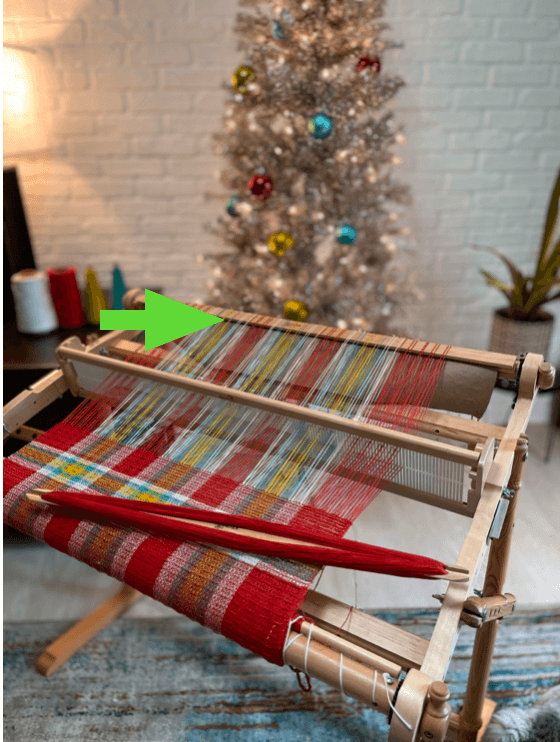
2.) Up – pick up forward, flat. If you are unsure of what that means, take a look at the following photos. This is the same step shown from two different angles.
Place the heddle in the Up position and slide the pick up stick forward, keeping it flat (horizontal to the floor). Bring it all the way forward so that it rests against the back of the heddle. Pass the weft through the shed.
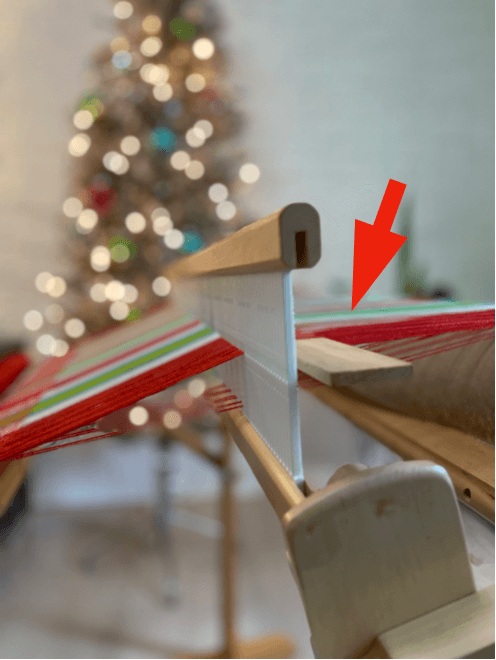

Next, the heddle will go 3.) Down then 4.) Up normally with the pick up slid back to the rear of the loom again.
The following step 5.) asks for the heddle to be put in Neutral – pick up forward, on edge. Notice in the 1st photo the pick up rests against the heddle block and in the 2nd, it’s all the way forward and against the back of the heddle. Either way is correct – which ever is more comfortable for you.
The last photo shows just how dramatically this will change the number of threads above the shuttle. This is what gives us the pattern design.
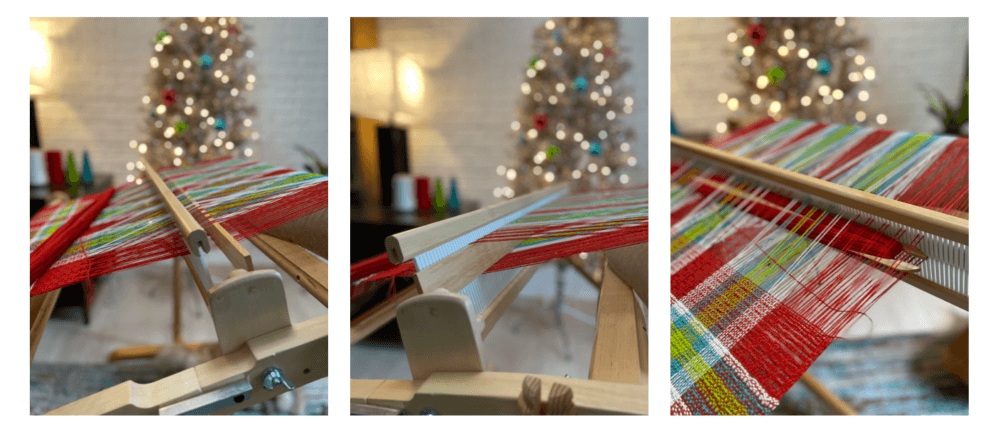
On the next pass, 6.) the heddle will be Up (with the pick up pushed back). On this pass it is important to wrap the weft around the end warp thread. If not, your edges will not be even. This occurs because the pick up prevents the last thread in the shed from opening at the edge, so we must close the gap created manually.
*If you begin the sequence from the left side, the end thread will need to be picked up on the 5th step, when the heddle is in neutral and the pick up and forward and on edge.

Notice on the last image that there is a gap at the edge. This is what will happen if the end thread is not wrapped.
Weave 10 repeats of the pattern (steps 1-6) in red.
Load your shuttles with small amounts of the remaining colors. If you don’t have enough shuttles, you can wind two colors onto one shuttle and just use them one at a time.
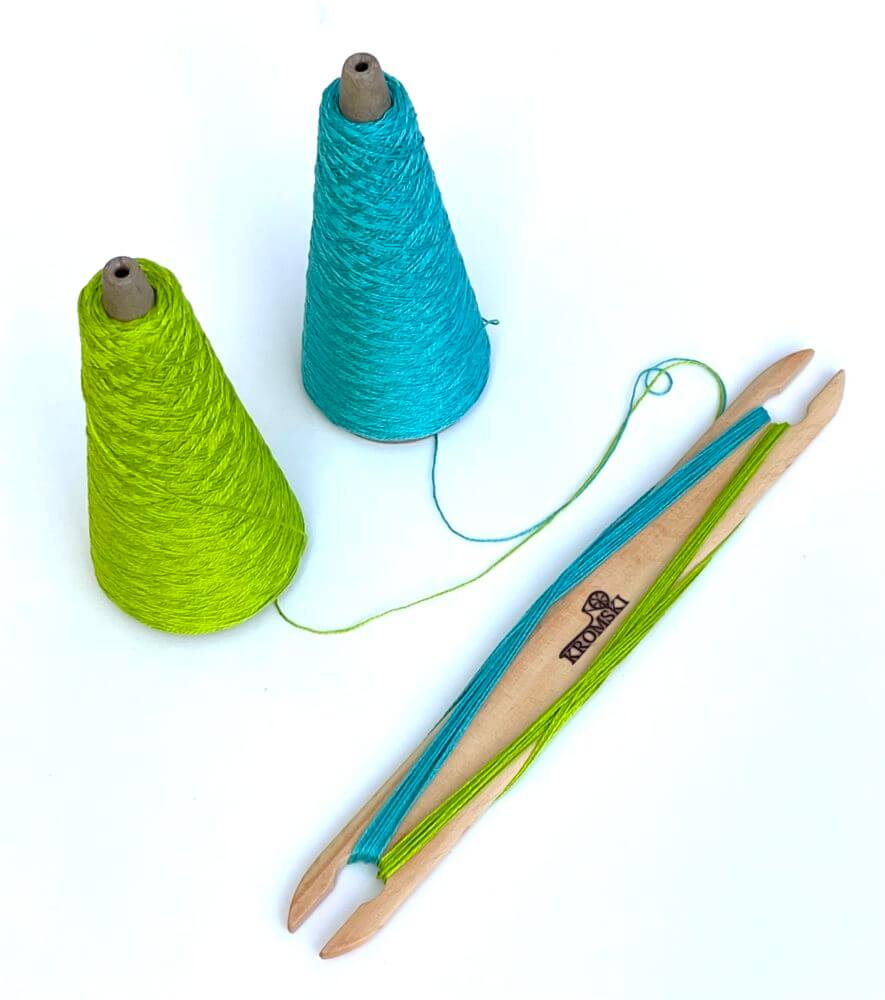
Cut the red and switch to the white yarn for one pattern set 1-6.
Change to turquoise for another set.
Weave steps 1-6 two times with green.
Repeat the sequence with turquoise, and again with white, for one set each.
Next weave the body of the towel with red for 18”. An easy way to keep track of the length is with a bit of scrap yarn and a strait pin. Cut about 24” of scrap yarn. Choose something that will not stretch. Tie a knot an inch or so from one end. Measure 18” from the knot and tie another knot. Use the strait pin like a cleat to hold it in place so that the knot lines up with the start of the red. Weave until you have reached the other knot.

Now you will repeat the white, turquoise and green stripes in the same way as you did before the 18” of red.
After the stripes weave another 10 pattern repeats of red and finish with 2.5” of plain weave for the hem. If you used a thinner thread for the hem, remember to do so again.
Weave 2 picks plain weave with waste yarn to separate your towels.
Repeat the above for the second towel.
After the last hem, weave a couple inches in waste yarn (or a bit extra red). Cut the project off the loom and tie knots in the warp to prevent it from unraveling. Alternately, sew several rows of zigzag stitch over the waste yarn.
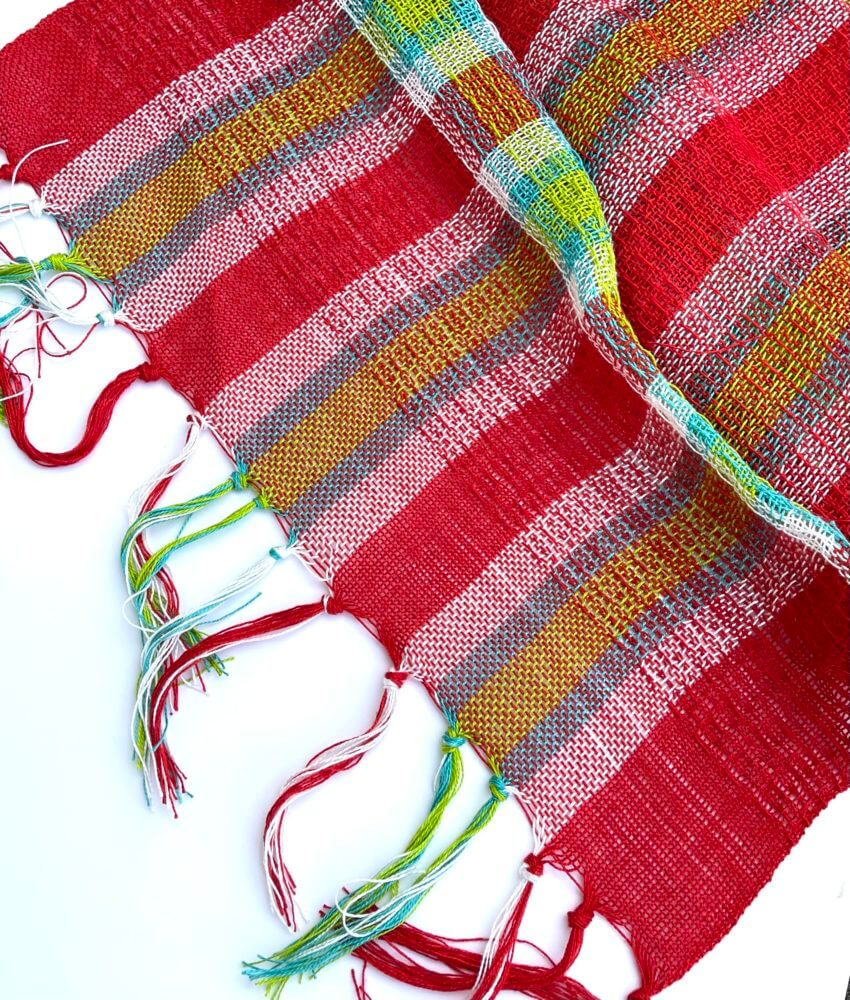
Wash the towels (do not cut them apart yet) in the washing machine using hot water and machine dry on high.
It helps to control wrinkles if you throw a towel in the dryer.
Finish by either hand or machine stitching the hems.
Now you may have been worried that your waffle pattern did not show enough as you were weaving.
Don’t worry, the wet finishing (washing and drying) will make a big difference in the final outcome. The cotton will shrink considerably in the wash and the towels will fluff up and become wonderfully soft and absorbent. The pattern will blossom and you will have a set of beautiful Christmas towels to treasure for years to come.
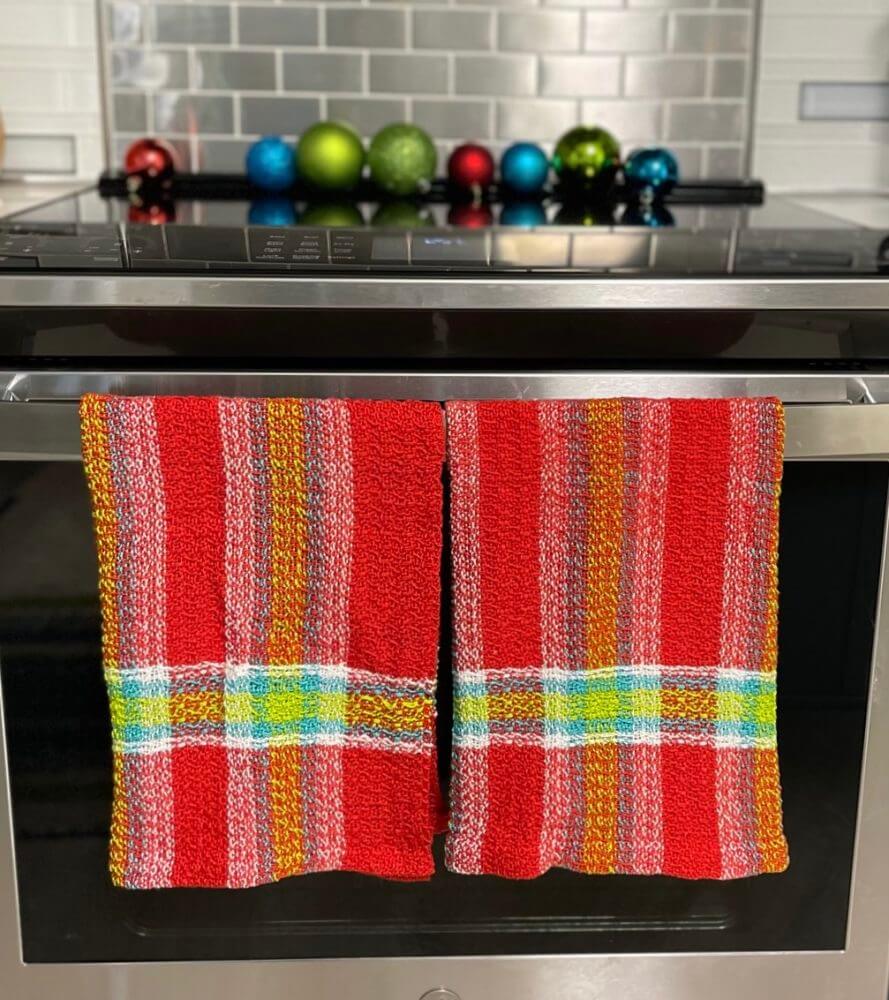
If you would like a pdf of this pattern click .




